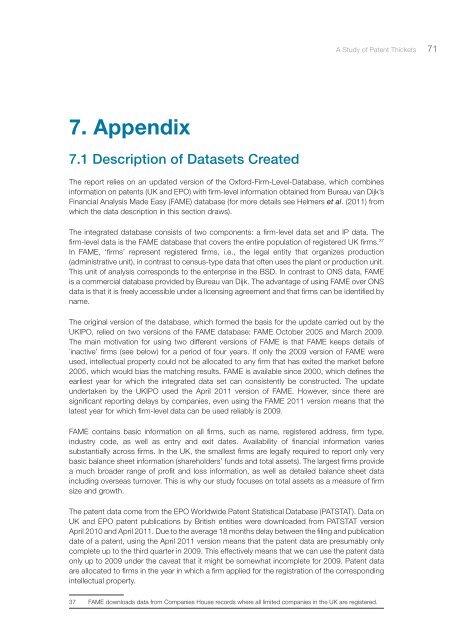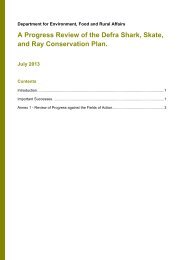A study of Patent Thickets (1.31Mb) - UK Intellectual Property Office
A study of Patent Thickets (1.31Mb) - UK Intellectual Property Office
A study of Patent Thickets (1.31Mb) - UK Intellectual Property Office
Create successful ePaper yourself
Turn your PDF publications into a flip-book with our unique Google optimized e-Paper software.
A Study <strong>of</strong> <strong>Patent</strong> <strong>Thickets</strong> 71<br />
7. Appendix<br />
7.1 Description <strong>of</strong> Datasets Created<br />
The report relies on an updated version <strong>of</strong> the Oxford-Firm-Level-Database, which combines<br />
information on patents (<strong>UK</strong> and EPO) with firm-level information obtained from Bureau van Dijk’s<br />
Financial Analysis Made Easy (FAME) database (for more details see Helmers et al. (2011) from<br />
which the data description in this section draws).<br />
The integrated database consists <strong>of</strong> two components: a firm-level data set and IP data. The<br />
firm-level data is the FAME database that covers the entire population <strong>of</strong> registered <strong>UK</strong> firms. 37<br />
In FAME, ‘firms’ represent registered firms, i.e., the legal entity that organizes production<br />
(administrative unit), in contrast to census-type data that <strong>of</strong>ten uses the plant or production unit.<br />
This unit <strong>of</strong> analysis corresponds to the enterprise in the BSD. In contrast to ONS data, FAME<br />
is a commercial database provided by Bureau van Dijk. The advantage <strong>of</strong> using FAME over ONS<br />
data is that it is freely accessible under a licensing agreement and that firms can be identified by<br />
name.<br />
The original version <strong>of</strong> the database, which formed the basis for the update carried out by the<br />
<strong>UK</strong>IPO, relied on two versions <strong>of</strong> the FAME database: FAME October 2005 and March 2009.<br />
The main motivation for using two different versions <strong>of</strong> FAME is that FAME keeps details <strong>of</strong><br />
`inactive’ firms (see below) for a period <strong>of</strong> four years. If only the 2009 version <strong>of</strong> FAME were<br />
used, intellectual property could not be allocated to any firm that has exited the market before<br />
2005, which would bias the matching results. FAME is available since 2000, which defines the<br />
earliest year for which the integrated data set can consistently be constructed. The update<br />
undertaken by the <strong>UK</strong>IPO used the April 2011 version <strong>of</strong> FAME. However, since there are<br />
significant reporting delays by companies, even using the FAME 2011 version means that the<br />
latest year for which firm-level data can be used reliably is 2009.<br />
FAME contains basic information on all firms, such as name, registered address, firm type,<br />
industry code, as well as entry and exit dates. Availability <strong>of</strong> financial information varies<br />
substantially across firms. In the <strong>UK</strong>, the smallest firms are legally required to report only very<br />
basic balance sheet information (shareholders’ funds and total assets). The largest firms provide<br />
a much broader range <strong>of</strong> pr<strong>of</strong>it and loss information, as well as detailed balance sheet data<br />
including overseas turnover. This is why our <strong>study</strong> focuses on total assets as a measure <strong>of</strong> firm<br />
size and growth.<br />
The patent data come from the EPO Worldwide <strong>Patent</strong> Statistical Database (PATSTAT). Data on<br />
<strong>UK</strong> and EPO patent publications by British entities were downloaded from PATSTAT version<br />
April 2010 and April 2011. Due to the average 18 months delay between the filing and publication<br />
date <strong>of</strong> a patent, using the April 2011 version means that the patent data are presumably only<br />
complete up to the third quarter in 2009. This effectively means that we can use the patent data<br />
only up to 2009 under the caveat that it might be somewhat incomplete for 2009. <strong>Patent</strong> data<br />
are allocated to firms in the year in which a firm applied for the registration <strong>of</strong> the corresponding<br />
intellectual property.<br />
37 FAME downloads data from Companies House records where all limited companies in the <strong>UK</strong> are registered.

















